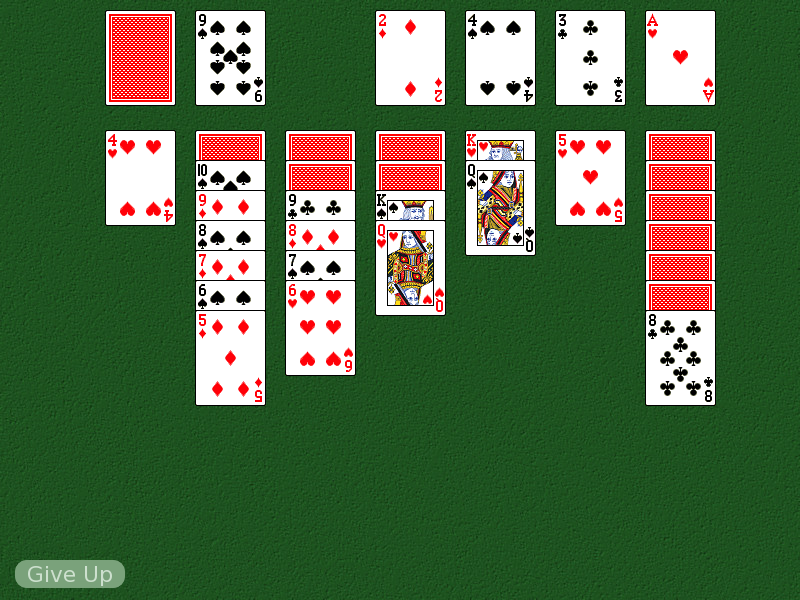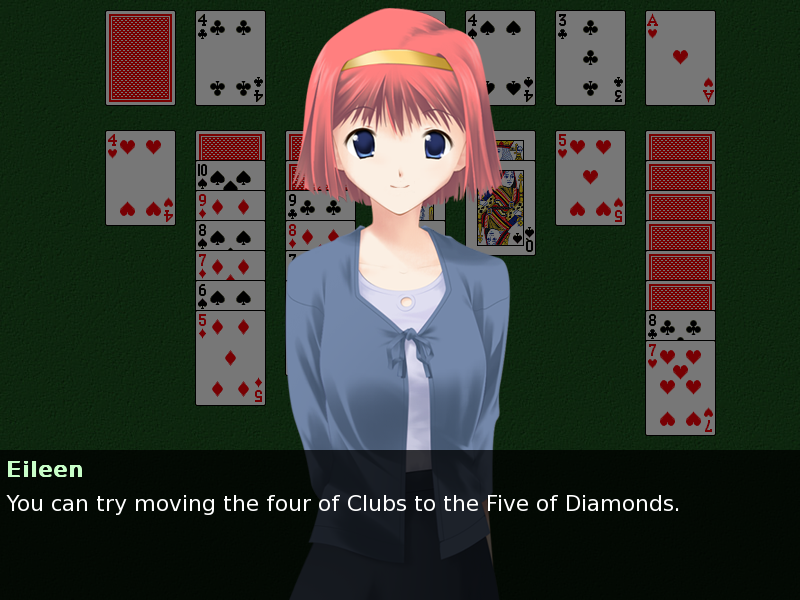This page is out of date
You've reached a page on the Ren'Py wiki. Due to massive spam, the wiki hasn't been updated in over 5 years, and much of the information here is very out of date. We've kept it because some of it is of historic interest, but all the information relevant to modern versions of Ren'Py has been moved elsewhere.
Some places to look are:
- The Ren'Py Home Page
- Download the Latest Version
- Ren'Py Documentation
- Quickstart Tutorial
- Ren'Py Cookbook
Please do not create new links to this page.
Cardgame


Cardgame is a framework that provides primitives for creating cardgames with Ren'Py. The cardgame engine does not actually implement any card games for you. Instead, it implements a set of primitives that are common to various card games:
- Cards
- Stacks of cards
- Clicking and double-clicking on a card or stack.
- Dragging cards between stacks
- Flipping cards over
Providing these primitives makes it easy to implement card games. (For example, an implementation of klondike solitaire takes 225 lines of code, including comments and blank lines.)
Cardgame is licensed under a different license from Ren'Py proper. It may be distributed for free with games that can be redistributed for free. Other users must purchase a commercial license.
The latest version of cardgame can be downloaded from the frameworks page.
__toc__
License
Cardgame is licensed under the following terms:
cardgame.rpy - Cardgame support for Ren'Py
Copyright (C) 2008 PyTom <pytom@bishoujo.us>
This software may be distributed in modified or unmodified form,
provided:
(1) This complete license notice is retained.
(2) This software and all software and data files distributed
alongside this software and intended to be loaded in the same
memory space may be redistributed without requirement for
payment, notification, or other forms of compensation.
THE SOFTWARE IS PROVIDED "AS IS", WITHOUT WARRANTY OF ANY KIND,
EXPRESS OR IMPLIED, INCLUDING BUT NOT LIMITED TO THE WARRANTIES OF
MERCHANTABILITY, FITNESS FOR A PARTICULAR PURPOSE AND
NONINFRINGEMENT. IN NO EVENT SHALL THE AUTHORS OR COPYRIGHT HOLDERS BE
LIABLE FOR ANY CLAIM, DAMAGES OR OTHER LIABILITY, WHETHER IN AN ACTION
OF CONTRACT, TORT OR OTHERWISE, ARISING FROM, OUT OF OR IN CONNECTION
WITH THE SOFTWARE OR THE USE OR OTHER DEALINGS IN THE SOFTWARE.
Commercial licenses are also available under reasonable terms, if you wish your game to be distributed commercially. Please email pytom@bishoujo.us for details.
Concepts
There are four concepts that are used by cardgame: tables, cards, stacks, and card events.
Table
Table objects are the fundamental displayable used by cardgame. A table may have multiple stacks and multiple cards defined underneath it, and takes care of displaying cards and stacks, and producing events in response to user input.
Tables should be displayed on the master layer using the show and hide methods. Adding a table to the transient layer may lead to confused card motion animation.
Tables do not display a background image underneath the stacks. Such an image can be displayed using the scene or show statements.
Card
Cardgame represents cards using hashable values provided by the user. Unlike tables, stacks, and events, cards are not objects produced by the cardgame, but instead can be objects or other values produced by the user. For example, the eight of spades might be represented as the tuple (1, 8). User-defined objects are also often acceptable.
Cards may be face-up or face-down. A card has two images associated with it: a face and a back. A card may either be part of a single stack, or may not belong to any stack. A card is only displayed if it belongs to a stack.
Stack
A stack represents a group of one or more cards. Each stack has a position relative to the table, and cards are displayed at offsets relative to that position. Stacks support many of the methods of a list, and also a few cardgame-specific methods. Stacks have a base image that is shown when the stack is empty.
CardEvent
When a table is shown and sensitive, calls to will return CardEvent objects in response to certain user operations.
Table
A table is created with the Table constructor:
This creates a new table.
back - A displayable giving the base of stacks of cards that do not specify a more specific base.
base - A displayable giving an image used as the base of stacks that do not specify a more specific base.
springback - The amount of time it takes for cards to spring to their new location when they have been moved between stacks, or dropped.
can_drag - A function that should return true if a card can be dragged. The function is given three arguments, the table, stack, and card that are being dragged. It should return True to allow the drag, or False otherwise. The default function returns True if the card being dragged is face up.
doubleclick - The maximum time between clicks for a doubleclick event to be recognized.
A table has the following methods:
Declares a new card.
value - A hashable value that is used to represent this card.
face - A displayable that's used for the face of this card.
back - If not None, a displayable that's used for the back of the card. Otherwise, the value of the back argument to the Table constructor is used.
Declares a new stack, and returns the stack object.
x, y - Give the x and y offsets of the center of the bottom-most card of the stack, or the base of the
xoff, yoff - The offsets of each card in the stack relative to the next-lower card in the stack.
show - The number of cards to show from the stack. If there are more than this number of cards in the stack, only the topmost show cards are shown.
base - An image that is used for the base of the stack, if no cards are in the stack. If this is None, the default base specified with the Table is used.
clicked - If True, this stack will return "click" and "doubleclick" events when the stack is clicked.
drag - Sets which cards, if any, participate in drags from this stack:
- DRAG_NONE - No dragging can occur.
- DRAG_CARD - Only the card being dragged will be dragged.
- DRAG_ABOVE - The card being dragged and all cards above it will be dragged.
- DRAG_STACK - All cards in the stack will be dragged.
- DRAG_TOP - The top card in the stack will be dragged.
drop - If True, this stack can be used as a drop target.
hidden - If True, this stack will not be shown on the screen.
Determines if this table will respond to events. If value is false, the table will stop responding to events until this is called with value true.
Determines if a card will be displayed face up or face down. Card is displayed face up if faceup is True.
Returns True if the named card is faceup, or False otherwise.
Sets the rotation of the card to rotation degrees. Rotation quality leaves something to be desired.
Returns the rotation of card, in degrees.
Adds marker to card. marker should be a displayable.
Removes marker from card.
Stacks
Stack support some basic list operations, like len(), indexing, membership tests, and iteration. The cards are placed in the list in bottom to top order. They also support the following methods:
Inserts card in the stack at index, where 0 is the bottom of the stack and len(s) is the bottom of the stack. If the card is in a stack, animates the card moving to the new stack.
Places card on the top of the stack. If the card is in a stack, animates the card moving to the top of the stack.
Removes card from the stack.
Removes the card at the top of the stack from the stack, and returns it. Returns None if the stack is empty.
Rearranges the cards in the stack in a random order.
CardEvent
CardEvent objects are returned from ui.interact() when events happen while a Table is sensitive. All event objects have the following fields defined:
- type - One of "drag", "click", or "doubleclick", giving the type of event this is.
- table - The table this event is associated with.
- stack - The stack that has been clicked or dragged from.
- card - The card that has been clicked or dragged. None for a click on the stack.
Drag events also have the following fields defined.
- drag_cards - A list of cards being dragged.
- drop_stack - The stack the cards are being dropped on.
- drop_card - The card the cards are being dropped on, if any, If this is None, the cards were dropped onto an empty stack.